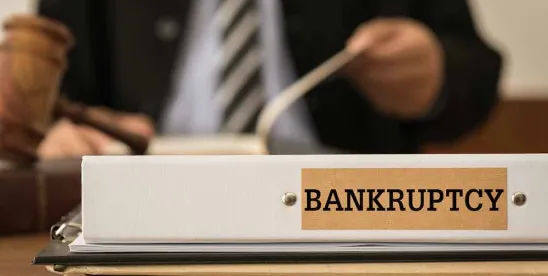In general, environmental law seeks to protect public health and the environment by providing for liability, compensation, cleanup, and emergency response to the release or disposal of hazardous substances. And more specifically, the Comprehensive Environmental, Response, Compensation, and Liability Act (“CERCLA”) seeks to address the remediation of existing hazardous waste sites and seeks to deter environmental hazards from developing in the future. As a result, CERCLA provides that a person, or entity, who is responsible for the creation of an environmental hazard should be liable for the costs of remedying the problem. The costs of cleaning up these contaminated sites can be staggering and quite often beyond the financial means of a potentially responsible party. When confronted with such cleanup liability, polluters often have, whether voluntarily or involuntarily, filed bankruptcy to obtain relief from their liabilities, including their environmental obligations, under bankruptcy law.
This article examines the aspects of environmental liability that may or may not be dischargeable in bankruptcy, including the efforts made to strike a balance between the competing policies underlying bankruptcy law and environmental law. More specifically, this article considers the effect of the automatic stay, the reach of the federal government’s regulatory or police power, and the options available to a debtor in possession of a contaminated property. However, before we can dive into those issues, we must first provide an overview of CERCLA and the various enforcement mechanisms employed by the U.S. Environmental Protection Agency (“EPA”) and the U.S. Department of Justice (“DOJ”) giving rise to environmental obligations.
While there are many important federal environmental statutes in effect,[1] the main federal environmental statute that arises in the bankruptcy context is CERCLA.[2] Congress enacted CERCLA to achieve two primary goals. First, CERCLA seeks to provide for the cleanup of hazardous substances that are actually released, or threatened to be released, into the environment. Second, CERCLA seeks to hold persons who are potentially responsible for the creation of an environmental hazard liable for the costs of such cleanup.[3] Under CERCLA, when there has been a release or threatened release of a “hazardous substance,”[4] EPA may pursue two courses of action. First, EPA may direct “potentially responsible parties” (“PRPs”) to perform the cleanup themselves if there exists an “imminent and substantial endangerment to public health or welfare or the environment.”[5] Second, EPA may undertake cleanup efforts itself, then seek reimbursement from the PRPs. Because EPA may undertake cleanup efforts itself, CERCLA, unlike other federal environmental statutes, is not purely regulatory in nature.
With respect to PRPs, CERCLA identifies four categories of entities that fall within this definition. The first category includes current “owners or operators” of the property on which the release has occurred or is threatened to occur.[6] The second category includes persons who owned or operated a property at the time of disposal or the release of a hazardous substance. The third category includes any person who has arranged for the disposal or treatment of, or arranged for the “transport”[7] of, hazardous waste for disposal or treatment at hazardous waste facilities. The fourth category includes any person who accepts or accepted hazardous waste for transport to a hazardous waste facility selected by the transporter.
EPA is tasked with enforcing CERCLA against PRPs, oftentimes through coordination with DOJ, and relies upon (1) civil administrative actions, (2) civil judicial actions, and (3) criminal enforcement actions to do so.[8] Civil enforcement actions can result in settlements, civil penalties, injunctive relief, and supplemental environmental projects (“SEPs”). In civil administrative actions, settlements often take the form of consent agreements/final orders or administrative orders on consent, and in civil judicial actions, settlements often take the form of consent decrees signed by all parties and filed in the appropriate court. Civil penalties, which are monetary assessments due to a violation or noncompliance, act as an incentive for coming into compliance and staying in compliance with environmental law, and they are designed to recover the economic benefit of noncompliance to compensate for the violation. Injunctive relief requires a regulated entity to perform, or refrain from performing, some designated action, and also brings a person or entity into compliance with environmental law. SEPs may be part of an enforcement settlement where a violator voluntarily agrees to undertake a remedial project to provide tangible environmental or public health benefits to the affected community or environment.[9] Finally, criminal enforcement actions, which are typically reserved for willful or knowing violations, can result in a defendant being ordered to pay penalties and/or restitution to those affected by the violation, and may also result in incarceration. When the costs of these enforcement actions become too much for PRPs, they often file bankruptcy, whether voluntarily or involuntarily, to obtain relief from their environmental obligations.
One of the fundamental protections offered by the U.S. Bankruptcy Code (the “Bankruptcy Code”) to a debtor is a statutorily imposed stay of virtually all collection efforts against the debtor. Pursuant to section 362(a) of the Bankruptcy Code, filing for bankruptcy operates as a stay of the “commencement or continuation . . . of a judicial, administrative or other action or proceeding against the debtor that was or could have been commenced before the commencement of the case . . ., or to recover a claim against the debtor that arose before the commencement of the case . . . .” This stay is imposed automatically upon the debtor filing its petition, hence the name “automatic stay.”
Not all actions or proceedings, however, are subject to the automatic stay. For example, the automatic stay does not apply to criminal proceedings against a debtor. Additionally, section 362(b) of the Bankruptcy Code specifically provides that the filing of a bankruptcy petition does not operate as a stay of “the commencement or continuation of an action or proceeding by a governmental unit . . . to enforce such governmental unit’s or organization’s police and regulatory power, including the enforcement of a judgment other than a money judgment, obtained in an action or proceeding by the governmental unit to enforce such governmental unit’s or organization’s police or regulatory power[.]”[10]
Environmental agencies typically argue that civil actions brought by the government to obtain an order directing a debtor to clean up a contaminated site are not subject to the automatic stay under the “police and regulatory power” exception. In response, debtors argue that, because environmental cleanup orders require debtors to expend funds, such orders are in the nature of monetary judgments and, thus, are not excepted from the automatic stay.
However, the majority of courts that have addressed the issue have held that prepetition environmental cleanup orders are not subject to the automatic stay, even where compliance with such an order might significantly deplete a debtor’s estate.[11] That is, courts have interpreted this exception to permit, for example, the continuation of a lawsuit under CERCLA seeking damages and injunctive relief against the debtors.[12]
A debtor in possession of a contaminated property has a few options available to it, including (1) retaining the contaminated property, in which case the debtor retains the cleanup obligations, (2) selling the contaminated property with the purchaser assuming cleanup obligations, (3) settling with applicable government authorities, which typically requires transferring the contaminated property into a trust, and (4) abandoning the contaminated property altogether in an effort to shed ongoing cleanup responsibility for the property.
Section 554 of the Bankruptcy Code authorizes a trustee to “abandon” or release from a debtor’s estate property that which is “burdensome” or of “inconsequential value and benefit to the estate.” Because the text of section 554 does not impose any conditions upon the abandonment power, trustees and debtors-in-possession have frequently sought to abandon property so as to avoid the debtor’s estate incurring liability for cleanup costs. Prior to 1986, several courts held that a trustee had an unfettered right to abandon property, regardless of the environmental problems on such property.[13] However, in 1986, the United States Supreme Court (the “Court”), held that a trustee’s ability to abandon contaminated property was qualified. Relying upon 28 U.S.C. § 959(b), which requires a bankruptcy trustee to manage and operate property of his or her estate “according to the requirements of the valid laws of the state in which such property is situated,” the Court held in Midlantic National Bank v. New Jersey Department of Environmental Protection that a trustee may not abandon contaminated property if such abandonment would violate state laws that protect legitimate governmental interests.[14] However, the Court wrote specifically that, to the extent abandonment would merely violate state statutes that were not “reasonably calculated to protect the public health or safety from imminent and identifiable harm,” a trustee would be allowed to abandon a hazardous waste site.[15] This “imminent and identifiable harm” limitation on a trustee’s abandonment power has been narrowly construed by most courts. Unless the health risk presented by the abandonment is “immediate,” courts typically permit a trustee to abandon the property.[16]
Ultimately, companies in financial distress due in whole or in part to environmental obligations, whether arising under CERCLA or any other environmental statute, should consult bankruptcy and environmental professionals to consider whether and to what extent that may offer a viable workout. Our firm routinely represents clients in both the bankruptcy space and the environmental space, working to find amicable solutions for all parties involved. We encourage clients to reach out to us if they have questions regarding how their environmental obligations may be treated in bankruptcy.
[1] Other important federal environmental statutes include the Clean Air Act, 42 U.S.C. § 7401 et seq., the Clean Water Act, 33 U.S.C. § 1251 et seq., the Resource Conservation and Recovery Act of 1976, 42 U.S.C. § 6091 et seq., and the Toxic Substances Control Act. 15 U.S.C. § 2601 et seq. However, because these federal environmental statutes are primarily regulatory in nature, as opposed to remedial in nature, this article will focus on CERCLA.
[2] 42 U.S.C. § 9601 et seq. CERCLA is a strict liability statute that establishes a scheme for the cleanup of sites contaminated with hazardous substances and a mechanism for placing the cost of that cleanup and related expense on to those responsible for the contamination.
[3] H.R. Rep. No. 253, 99th Cong., 2d Sess. 15 (1986).
[4] CERCLA defines “hazardous substance” generally as any substance which, when released into the environment, may reasonably be anticipated to cause death, disease, abnormalities, reproductive and genetic malfunctions, or physical deformities. 42 U.S.C. § 9601(14). Certain substances are excluded from the definition of “hazardous substance,” including petroleum, crude oil, natural gas, natural gas liquids, liquified natural gas, and synthetic gas usable for fuel. Id.
[5] 42 U.S.C. § 9606(a).
[6] The determining of whether a secured party is an “owner or operator” so as to impose liability under CERCLA is one of the most frequently litigated issues concerning liability under CERCLA.
[7] 42 U.S.C. § 9601(26) (defining “transport”).
[8] Basic Information on Enforcement, EPA (Dec. 18, 2023), https://www.epa.gov/enforcement/basic-information-enforcement#:~:text=Enforcing%20environmental%20laws%20is%20a,against%20violators%20of%20environmental%20laws. Of course, various state agencies enforce state environmental programs and common law theories of liability.
[9] With a SEP, the violator goes beyond what is required of it under environmental law, and the voluntary agreement to perform a SEP is one factor to be considered by EPA in determining an appropriate civil penalty. Supplemental Environmental Projects (SEPs), EPA, (Dec. 7, 2023), https://www.epa.gov/enforcement/supplemental-environmental-projects-seps.
[10] 11 U.S.C. § 362(b)(4).
[11] In re Torwico Elecs., Inc., 8 F.3d 146, 150 (3d Cir. 1993); In re CMC Heartland Partners, 966 F.2d 1143, 1147 (7th Cir. 1992); In re Chateaugay Corp., 944 F.2d 997, 997 (2d Cir. 1991); In re Commonwealth Oil Refining Co., 805 F.2d 1175 (5th Cir. 1986), cert. denied, 483 U.S. 1005 (1987); State of New Jersey Dep’t of Env’t Res. v. Madison Indus., 161 B.R. 363 (D.N.J. 1993); United States v. F.E. Gregory & Sons, Inc., 58 B.R. 590 (W.D. Pa. 1986); In re Ilco, Inc., 48 B.R. 1016 (N.D. Ala. 1985); In re Microfab, 105 B.R. 152 (Bankr. D. Mass. 1989); In re Kaiser Steel Corp., 87 B.R. 662 (Bankr. D. Colo. 1988).
[12] See, e.g., City of New York v. Exxon Corp., 932 F.2d 1020 (2d Cir. 1991).
[13] See In re A & T Trailer Park, Inc., 53 B.R. 144 (Bankr. D. Wy. 1985); In re Union Scrap Iron & Metal Co., 49 B.R. 477 (Bankr. D. Minn. 1985).
[14] Midlantic Nat’l Bank v. New Jersey Dep’t of Env’t Prot., 474 U.S. 494 (1986).
[15] Id. at 507 n.9.
[16] In re L.F. Jennings Oil Co., 4 F.3d 887 (10th Cir. 1993), cert. denied, 114 S. Ct. 1372 (1994); Leavell v. Karnes, 143 B.R. 212 (S.D. Ill. 1990); In re Brio Refining, Inc., 86 B.R. 487 (N.D. Tex. 1988); In re Southern Intern. Co., 165 B.R. 815 (Bankr. E.D. Va. 1994); In re H.F. Radandt, 160 B.R. 323 (Bankr. W.D. Wis. 1993).






 />i
/>i
